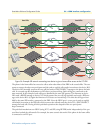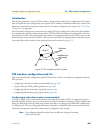
ISDN interface configuration task list 402
SmartWare Software Configuration Guide 34 • ISDN interface configuration
• caller-name early-alerting <timeout>: This configuration command specifies the behaviour for incoming
ISDN calls. Some networks only deliver the name after an alerting indication. These networks simulate the
mid-ring name delivery feature of analog lines. If early alerting is enabled, we send back a faked ALERT-
ING message after a configurable timeout when we receive a NameInformationFollowing indication. This
command can be used together with the ignore-absence command. For example, you can configure an
interface to first generate an ALERTING message and later forward the call anyway. If used that way, the
early-alerting timeout should be smaller than the ignore-absence timeout.
• caller-name send-information-following: This configuration command specifies the behaviour for outgo-
ing ISDN calls. If there is no name from the originating network, the ISDN interface configured with this
command sends a NameInformationFollowing indication to the remote side itself.
The following example enables and configures the caller-name feature on a T1 ISDN interface for incoming
calls. If no name is present in the SETUP message, but the SETUP message contains the NameInformationFol-
lowing indication, an ALERTING message is sent back after 500ms. If there is no name after additional 500ms
the call is routed to the destination network anyway.
Mode: context cs / interface isdn
Step Command Purpose
1 node(if-isdn)#caller-name Enables reception of the caller-name.
2 node(if-isdn)#caller-name early-alerting
500
(optional) If no name is present in an incoming
ISDN call and if the incoming SETUP message con-
tains the NameInformationFollowing indication,
we send a fake ALERTING message after 500ms
towards the caller. The SETUP message is retained
for this period, i.e. the call is not forwarded to the
configured destination.
This step is optional. When not configured, an
ALERTING message is faked after 2s by default.
You can disable faking an ALERTING message by
using the “no” form of the command.
Note: If the ignore-absence timeout is also config-
ured, the early-alerting timeout should have a
smaller value than the ignore-absence timeout.


















